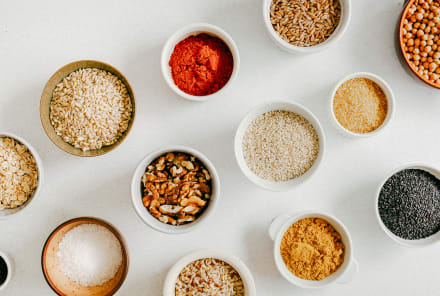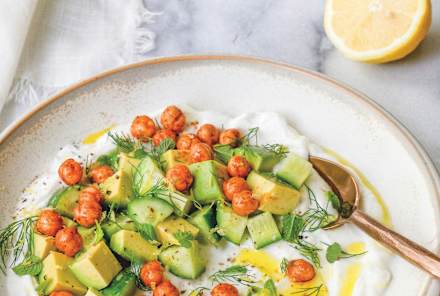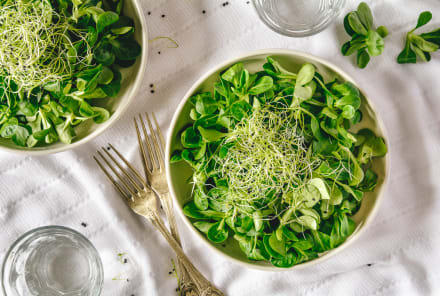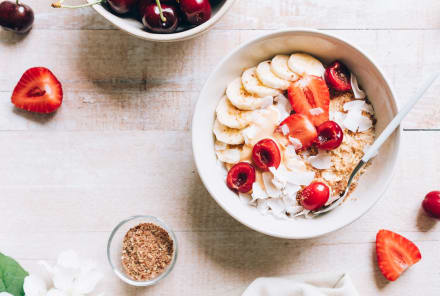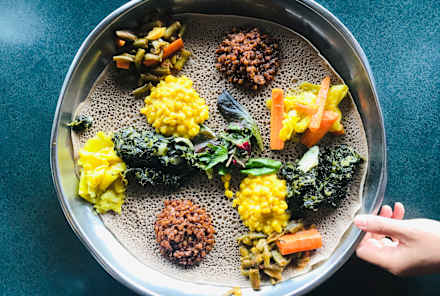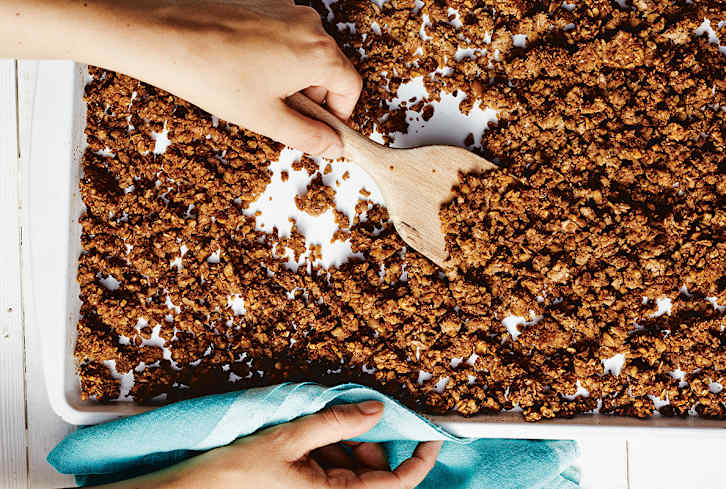Advertisement
Everything You Need To Know About Using A Low-FODMAP Diet To Treat IBS

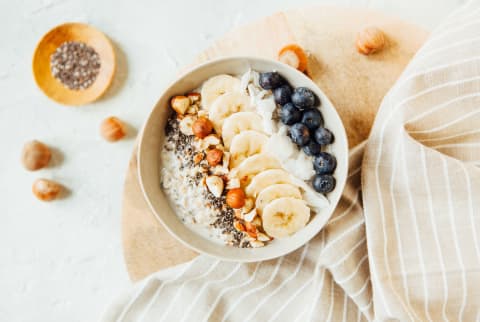
There's a reason the low-FODMAP diet is relatively unknown and can seem intimidating to the uninitiated—and it's not just because it has an ambiguous name (don't worry, you're not the only one who was picturing a map made of food). The low-FODMAP diet is not a "lifestyle" diet or intended for weight loss. It follows a very specific eating plan that cuts out and reintroduces foods in an effort to ease and improve digestive issues such as irritable bowel syndrome (IBS).
Whether a nutritionist recommended it, you came across it in desperate research to help your problematic gut, or you just heard the name and thought What the &*#^ is that? here's everything you need to know about the low-FODMAP diet.
What is the low-FODMAP diet, and where did it come from?
First things first: FODMAP stands for "Fermentable Oligo-, Di-, Monosaccharides And Polyols." Translation: "FODMAP" foods are carbohydrates, and specifically carbs that are somewhat notorious for causing digestive issues. So, a low-FODMAP diet starts with cutting out foods that are high in these pesky carbs.
The low-FODMAP diet was developed by a team of gastroenterologists at Australia's Monash University in 2005. These physician researchers set out specifically to find an answer for the one in seven people worldwide who suffer from IBS. They found that IBS symptoms like bloating, abdominal pain, and constipation could be significantly decreased by cutting out high-FODMAP foods.
How does it work, and what are the benefits?
You might be saying to yourself "Sure, it sounds great. But how does it work?" The Monash University researchers figured that out for you. Because of the small size of FODMAP carbohydrates, they tend to attract water into the intestine. When this liquid interacts with the gut bacteria in the large intestine, it starts a fermentation process and ultimately produces gas. This gas is what then creates the unpleasant symptoms of IBS.
So how do you prevent those high-FODMAP foods from being fermented by bacteria and creating gas? You cut them out of your diet. It can truly make a notable difference for people who experience the painful, uncomfortable, and sometimes even embarrassing symptoms of IBS.
"One study found a low-FODMAP diet improved symptoms in about 68 to 76 percent1 of IBS patients—results I've seen in my own practice," Vincent Pedre, M.D., gut health specialist and medical director of Pedre Integrative Health, told mbg. "IBS aside, a low-FODMAP diet helps a variety of gut conditions including Crohn's disease, celiac disease, inflammatory bowel disease, and even small-intestinal bacterial overgrowth (SIBO)."
High-FODMAP foods.
Step one in the low-FODMAP diet is identifying which foods are high in FODMAPs and making a plan to avoid them. If you're exploring the low-FODMAP diet as an option, be aware that these foods will need to be eliminated from your diet in the beginning:
- Vegetables: cauliflower, corn, mushrooms, snow peas, artichoke, asparagus, broccoli, Brussels sprouts, garlic, fennel, onion, leeks
- Legumes: chickpeas, lentils, beans, edamame
- Fruits: apples, apricots, blackberries, pears, peaches, watermelon, plums, prunes, cherries, mango, figs
- Sweeteners: honey, agave, high-fructose corn syrup, sugar alcohols (xylitol, sorbitol, maltitol)
- Grains: wheat, rye, barley
- Nuts: pistachios, cashews
- Dairy: milk, fresh and soft cheeses, sour cream, yogurt, ice cream

Low-FODMAP foods.
In the first three to eight weeks of the low-FODMAP diet, you'll want to restrict your eating to these foods. People often assume that the diet means cutting out high-FODMAP foods forever, but it's really a few weeks of restriction and then a slow reintroduction of some high-FODMAP foods. So at first, you'll want to stick to these low-FODMAP foods only:
- Vegetables: eggplant, arugula, bok choy, bell peppers, carrots, celery, cucumber, zucchini, sweet potatoes, squash, kale, lettuce, cabbage, spinach
- Meats, fish, eggs: These protein sources are all fine on the low-FODMAP diet.
- Fruits: cantaloupe, grapes, blueberries, orange, pineapple, strawberry, kiwi, grapefruit
- Sweeteners: pure maple syrup, white sugar, brown sugar, stevia
- Grains: quinoa, rice, oats
- Nuts and seeds: macadamia nuts, peanuts, pumpkin seeds, walnuts, almonds, sesame seeds
- Dairy: hard cheeses, nondairy alternatives
- Fats and oils
Pedre recommends downloading the Monash University Low-FODMAP Diet App to help you select low-FODMAP foods when you're traveling, at restaurants, or at the grocery store.
Tips for getting started on a low-FODMAP diet.
It's important to remember that many high-FODMAP foods are considered very healthy. They're not being restricted on this diet because they lack nutritional value but because many people have sensitivities to this type of carb. Also, keep in mind that low-FODMAP means less dietary fiber, so you might want to consider a low-FODMAP fiber supplement such as rice bran or oat bran.
To get started you'll need to begin the elimination phase. Cut all high-FODMAP foods from your diet for three to eight weeks. As you begin reintroducing them slowly, keep a food diary to track any foods that give your gut a hard time. Nutritionists recommend that when reintroducing foods, you start with individual food groups. For example, try adding back grains for a week and see how you feel. The next week, add back various forms of dairy, and onward. This will help you identify the problem foods more easily.
Whether you've been living with irritable bowel syndrome for years, you're newly diagnosed, or you're just looking for an answer for serious tummy troubles, the low-FODMAP diet is a tried-and-true way to address these woes.

Why Nutrition Is Key To Changing Your Relationship With Alcohol
Brooke Scheller, DCN, CNS

Why Alcohol Sabotages Your Gut Health & How To Get Back On Track
Brooke Scheller, DCN, CNS

Why Nutrition Is Key To Changing Your Relationship With Alcohol
Brooke Scheller, DCN, CNS

Why Alcohol Sabotages Your Gut Health & How To Get Back On Track
Brooke Scheller, DCN, CNS

Why Nutrition Is Key To Changing Your Relationship With Alcohol
Brooke Scheller, DCN, CNS

Why Alcohol Sabotages Your Gut Health & How To Get Back On Track
Brooke Scheller, DCN, CNS

Why Nutrition Is Key To Changing Your Relationship With Alcohol
Brooke Scheller, DCN, CNS

Why Alcohol Sabotages Your Gut Health & How To Get Back On Track
Brooke Scheller, DCN, CNS
